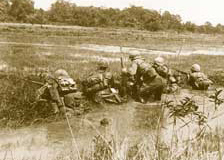The War in Vietnam
Dissatisfaction with the Great Society came to be more than matched by unhappiness with the situation in Vietnam. A series of South Vietnamese strong men proved little more successful than Diem in mobilizing their country. The Viet Cong, insurgents supplied and coordinated from North Vietnam, gained ground in the countryside.

A U.S. Army unit searches for snipers while on patrol in South Vietnam in 1965. From 60,000 troops in 1965, U.S. forces grew to more than 540,000 by 1969, in a conflict that divided the nation more bitterly than any other in the 20th century. The last U.S. combat forces left Vietnam in 1973.
(U.S. Army)
Determined to halt Communist advances in South Vietnam, Johnson made the Vietnam War his own. After a North Vietnamese naval attack on two American destroyers, Johnson won from Congress on August 7, 1964, passage of the Gulf of Tonkin Resolution, which allowed the president to "take all necessary measures to repel any armed attack against the forces of the United States and to prevent further aggression." After his re-election in November 1964, he embarked on a policy of escalation. From 25,000 troops at the start of 1965, the number of soldiers -- both volunteers and draftees -- rose to 500,000 by 1968. A bombing campaign wrought havoc in both North and South Vietnam.
Grisly television coverage with a critical edge dampened support for the war. Some Americans thought it immoral; others watched in dismay as the massive military campaign seemed to be ineffective. Large protests, especially among the young, and a mounting general public dissatisfaction pressured Johnson to begin negotiating for peace.
